HONDA CR-Z 2011 1.G Owners Manual
Manufacturer: HONDA, Model Year: 2011, Model line: CR-Z, Model: HONDA CR-Z 2011 1.GPages: 333, PDF Size: 9.97 MB
Page 221 of 333
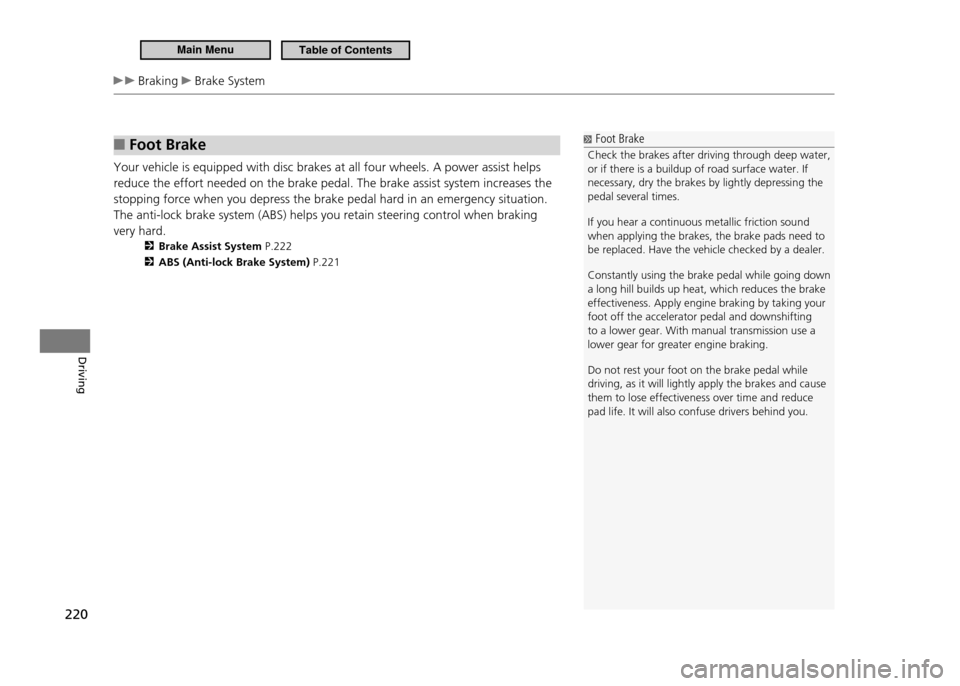
220
Driving
Braking Brake System
Foot Brake
■
Your vehicle is equipped with disc brakes at all four wheels. A power assist helps reduce the effort needed on the brake pedal. The brake assist system increases the stopping force when you depress the brake pedal hard in an emergency situation. The anti-lock brake system (ABS) helps you retain steering control when braking very hard.
Brake Assist System P.222
ABS (Anti-lock Brake System) P.221
Foot Brake
Check the brakes after driving through deep water, or if there is a buildup of road surface water. If necessary, dry the brakes by lightly depressing the pedal several times. If you hear a continuous metallic friction sound when applying the brakes, the brake pads need to be replaced. Have the vehicle checked by a dealer.
Constantly using the brake pedal while going down a long hill builds up heat, which reduces the brake effectiveness. Apply engine braking by taking your foot off the accelerator pedal and downshifting to a lower gear. With manual transmission use a lower gear for greater engine braking. Do not rest your foot on the brake pedal while driving, as it will lightly apply the brakes and cause them to lose effectiveness over time and reduce pad life. It will also confuse drivers behind you.
Main MenuTable of Contents
Page 222 of 333
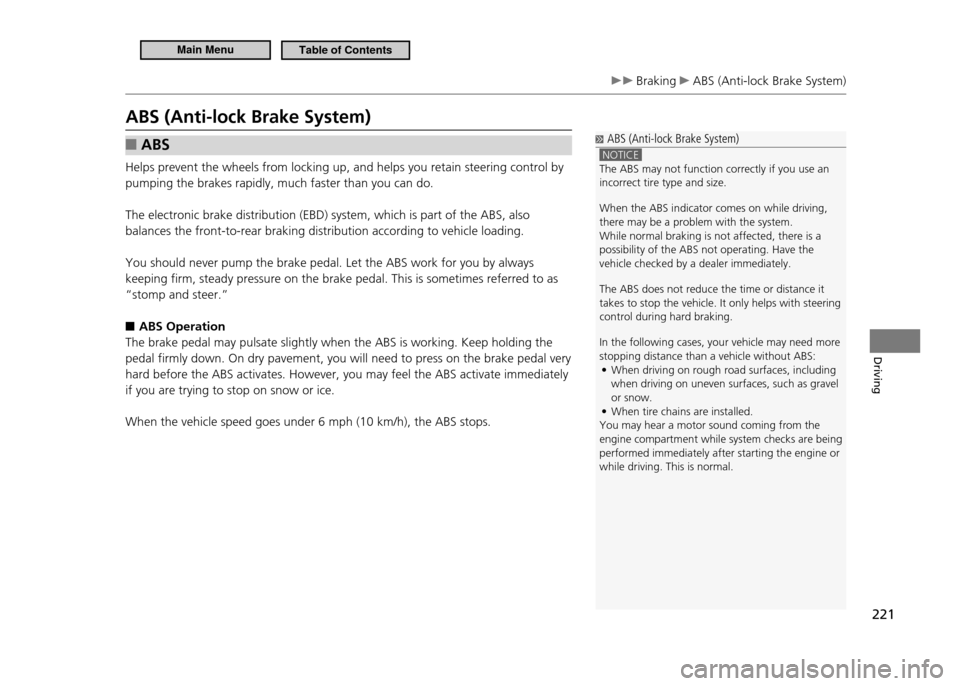
221
Driving
Braking ABS (Anti-lock Brake System)
ABS (Anti-lock Brake System)
ABS
■
Helps prevent the wheels from locking up, and helps you retain steering control by pumping the brakes rapidly, much faster than you can do. The electronic brake distribution (EBD) system, which is part of the ABS, also balances the front-to-rear braking distribution according to vehicle loading. You should never pump the brake pedal. Let the ABS work for you by always keeping firm, steady pressure on the brake pedal. This is sometimes referred to as “stomp and steer.”
ABS Operation
■
The brake pedal may pulsate slightly when the ABS is working. Keep holding the pedal firmly down. On dry pavement, you will need to press on the brake pedal very hard before the ABS activates. However, you may feel the ABS activate immediately if you are trying to stop on snow or ice. When the vehicle speed goes under 6 mph (10 km/h), the ABS stops.
ABS (Anti-lock Brake System)
NOTICE The ABS may not function correctly if you use an incorrect tire type and size. When the ABS indicator comes on while driving, there may be a problem with the system.While normal braking is not affected, there is a possibility of the ABS not operating. Have the vehicle checked by a dealer immediately. The ABS does not reduce the time or distance it takes to stop the vehicle. It only helps with steering control during hard braking. In the following cases, your vehicle may need more stopping distance than a vehicle without ABS: When driving on rough road surfaces, including
•
when driving on uneven surfaces, such as gravel or snow.When tire chains are installed.
•
You may hear a motor sound coming from the
engine compartment while system checks are being performed immediately after starting the engine or while driving. This is normal.
Main MenuTable of Contents
Page 223 of 333
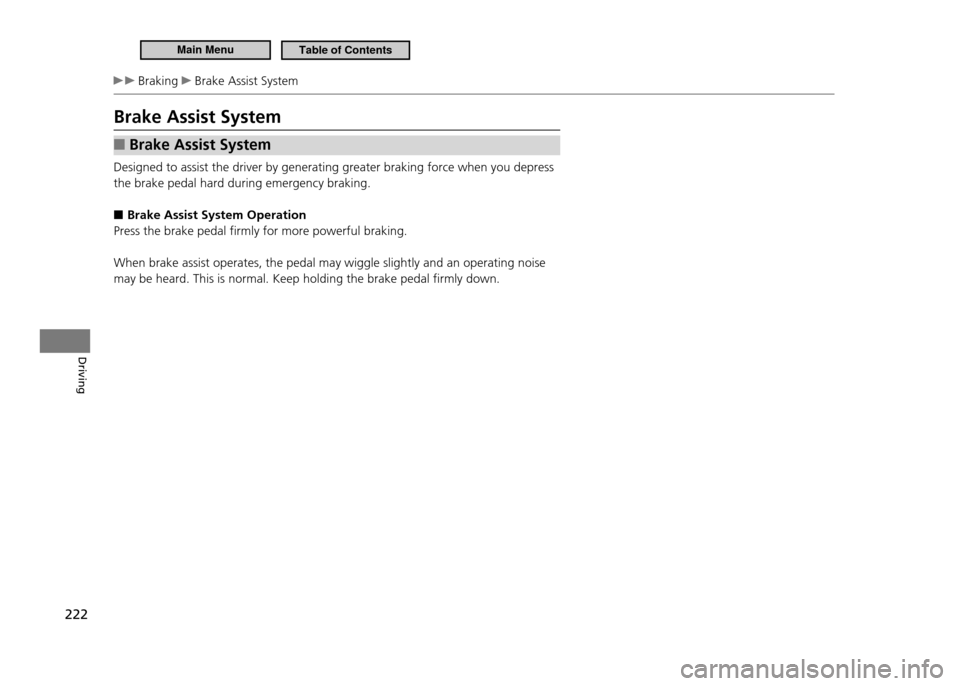
222
Driving
Braking Brake Assist System
Brake Assist System
Brake Assist System
■
Designed to assist the driver by generating greater braking force when you depress the brake pedal hard during emergency braking.
Brake Assist System Operation
■
Press the brake pedal firmly for more powerful braking. When brake assist operates, the pedal may wiggle slightly and an operating noise may be heard. This is normal. Keep holding the brake pedal firmly down.
Main MenuTable of Contents
Page 224 of 333
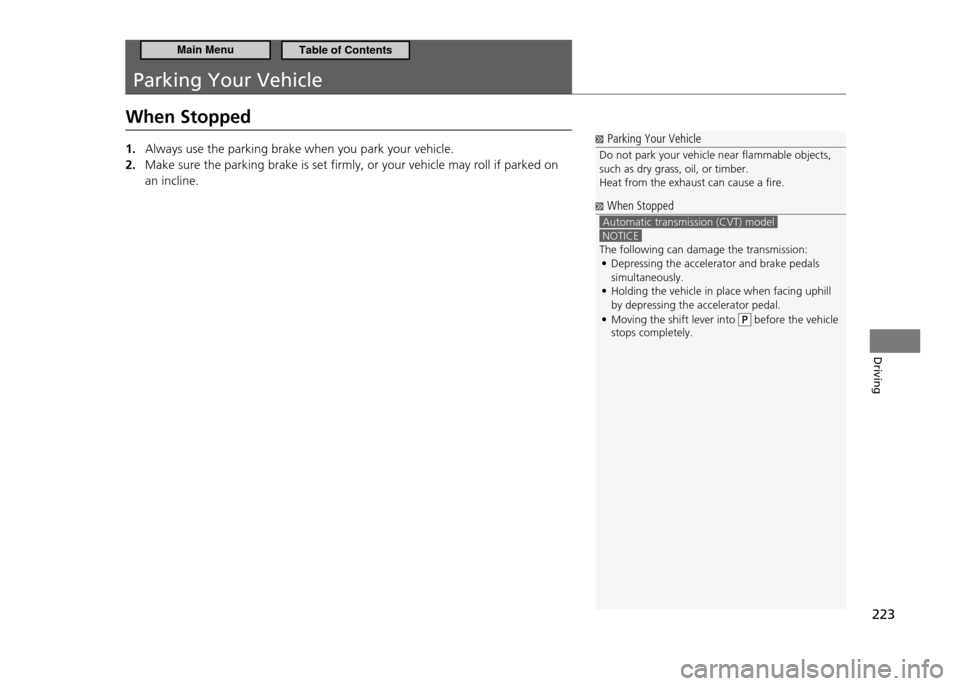
223
Driving
Parking Your Vehicle
When Stopped
Parking Your Vehicle
Do not park your vehicle near lammable objects, such as dry grass, oil, or timber.Heat from the exhaust can cause a ire.
When Stopped
Automatic transmission (CVT) model NOTICE
The following can damage the transmission: Depressing the accelerator and brake pedals
•
simultaneously. Holding the vehicle in place when facing uphill
•
by depressing the accelerator pedal. Moving the shift lever into
•
before the vehicle
stops completely.
Always use the parking brake when you park your vehicle.
1.
Make sure the parking brake is set firmly, or your vehicle may roll if parked on
2.
an incline.
Main MenuTable of Contents
Page 225 of 333
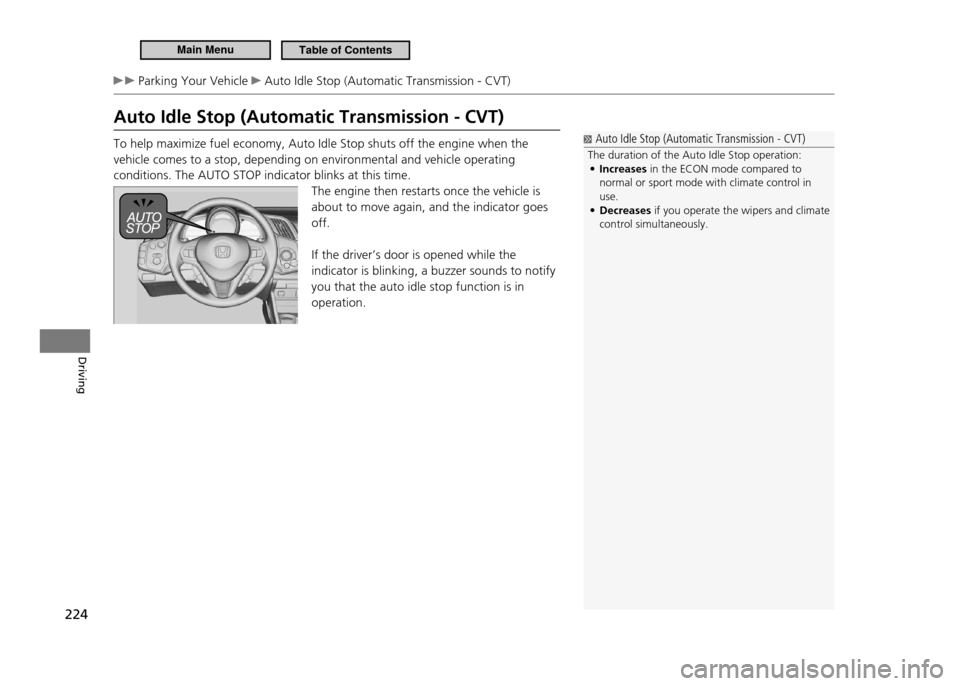
224
Driving
Parking Your Vehicle Auto Idle Stop (Automatic Transmission - CVT)
Auto Idle Stop (Automatic Transmission - CVT) To help maximize fuel economy, Auto Idle Stop shuts off the engine when the vehicle comes to a stop, depending on environmental and vehicle operating conditions. The AUTO STOP indicator blinks at this time.The engine then restarts once the vehicle is about to move again, and the indicator goes off. If the driver’s door is opened while the indicator is blinking, a buzzer sounds to notify you that the auto idle stop function is in operation.
Auto Idle Stop (Automatic Transmission - CVT)
The duration of the Auto Idle Stop operation: Increases
• in the ECON mode compared to
normal or sport mode with climate control in use.Decreases
• if you operate the wipers and climate
control simultaneously.
Main MenuTable of Contents
Page 226 of 333
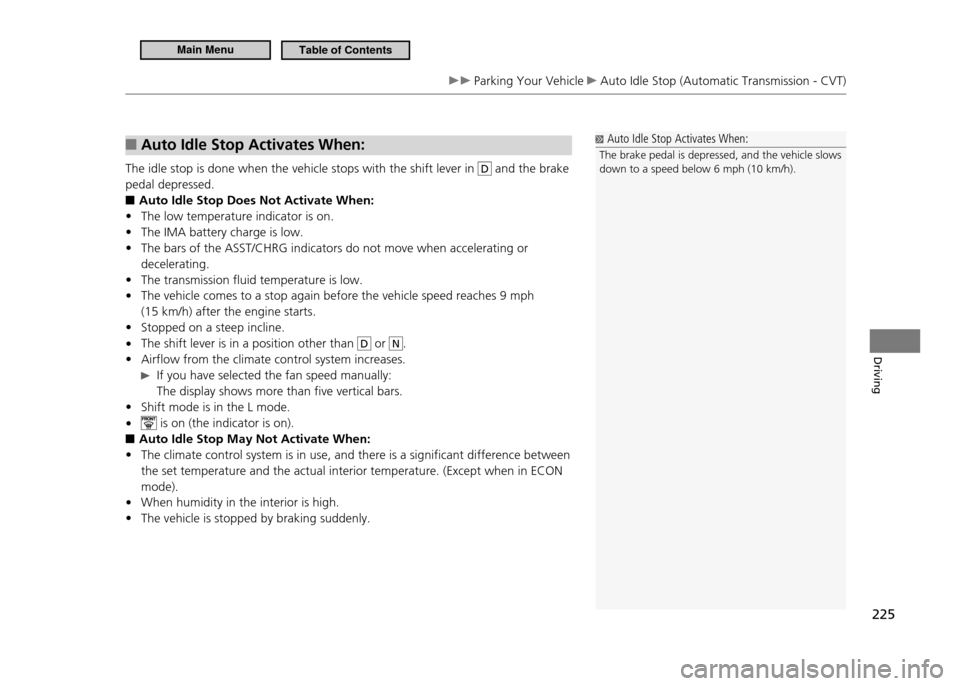
225
Driving
Parking Your Vehicle Auto Idle Stop (Automatic Transmission - CVT)
Auto Idle Stop Activates When:
■
The idle stop is done when the vehicle stops with the shift lever in D and the brake
pedal depressed. Auto Idle Stop Does Not Activate When:
■
The low temperature indicator is on.
•
The IMA battery charge is low.
•
The bars of the ASST/CHRG indicators do not move when accelerating or
•
decelerating. The transmission fluid temperature is low.
•
The vehicle comes to a stop again before the vehicle speed reaches 9 mph
•
(15 km/h) after the engine starts.Stopped on a steep incline.
•
The shift lever is in a position other than
•
D or N.
Airflow from the climate control system increases.
•
If you have selected the fan speed manually:
The display shows more than five vertical bars.
Shift mode is in the L mode.
•
• is on (the indicator is on).
Auto Idle Stop May Not Activate When:
■
The climate control system is in use, and there is a significant difference between
•
the set temperature and the actual interior temperature. (Except when in ECON mode).When humidity in the interior is high.
•
The vehicle is stopped by braking suddenly.
•
Auto Idle Stop Activates When:
The brake pedal is depressed, and the vehicle slows down to a speed below 6 mph (10 km/h).
Main MenuTable of Contents
Page 227 of 333
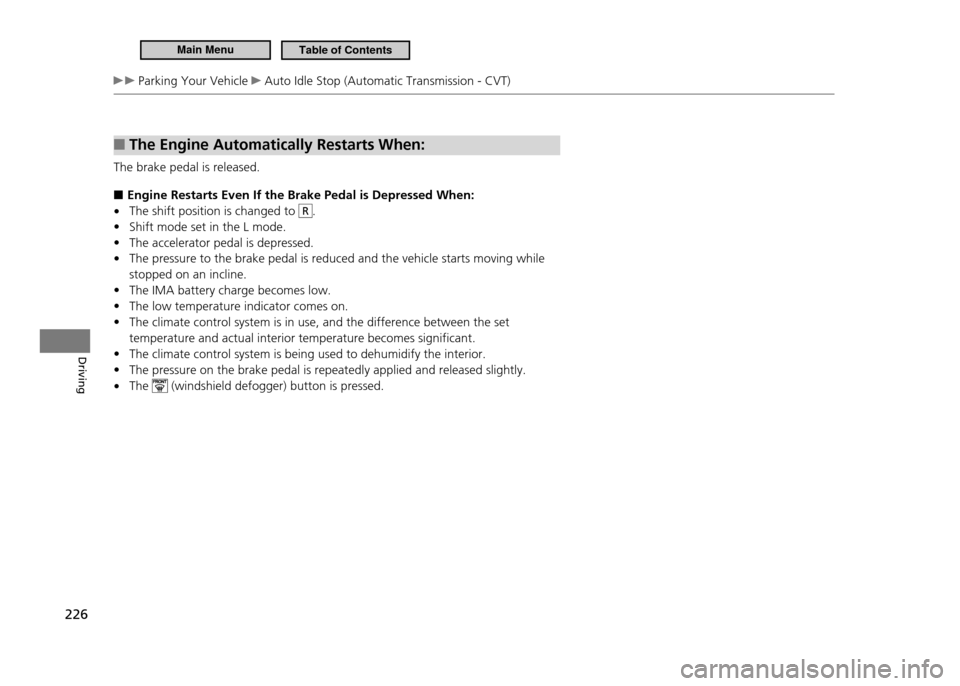
226
Driving
Parking Your Vehicle Auto Idle Stop (Automatic Transmission - CVT)
The Engine Automatically Restarts When:
■
The brake pedal is released.
Engine Restarts Even If the Brake Pedal is Depressed When:
■
The shift position is changed to
•
R.
Shift mode set in the L mode.
•
The accelerator pedal is depressed.
•
The pressure to the brake pedal is reduced and the vehicle starts moving while
•
stopped on an incline. The IMA battery charge becomes low.
•
The low temperature indicator comes on.
•
The climate control system is in use, and the difference between the set
•
temperature and actual interior temperature becomes significant.The climate control system is being used to dehumidify the interior.
•
The pressure on the brake pedal is repeatedly applied and released slightly.
•
The
•
(windshield defogger) button is pressed.
Main MenuTable of Contents
Page 228 of 333
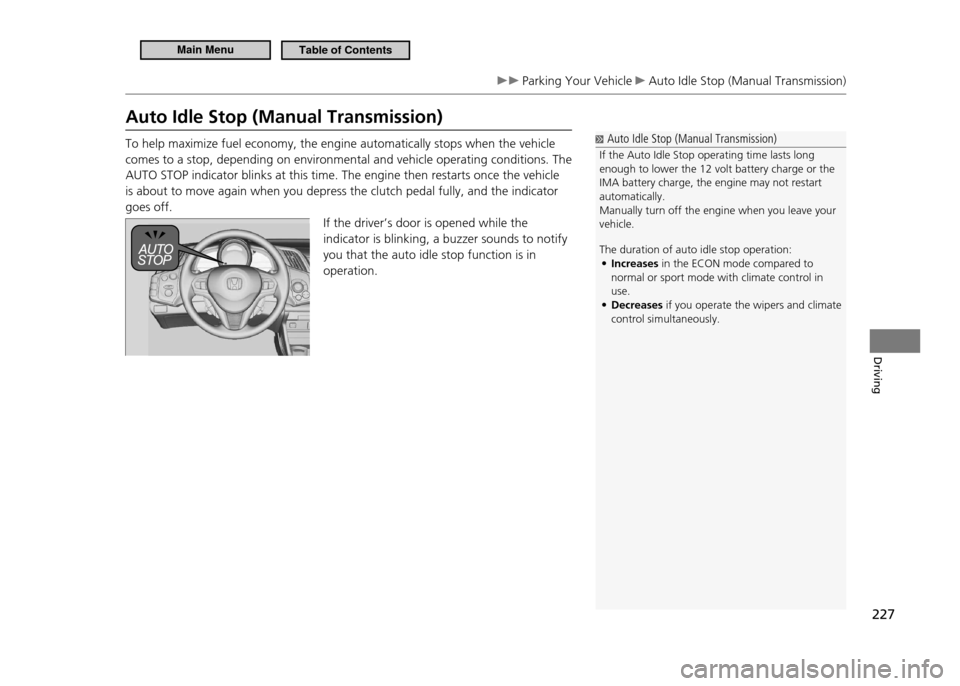
227
Driving
Parking Your Vehicle Auto Idle Stop (Manual Transmission)
Auto Idle Stop (Manual Transmission) To help maximize fuel economy, the engine automatically stops when the vehicle comes to a stop, depending on environmental and vehicle operating conditions. The AUTO STOP indicator blinks at this time. The engine then restarts once the vehicle is about to move again when you depress the clutch pedal fully, and the indicator goes off.If the driver’s door is opened while the indicator is blinking, a buzzer sounds to notify you that the auto idle stop function is in operation.
Auto Idle Stop (Manual Transmission)
If the Auto Idle Stop operating time lasts long enough to lower the 12 volt battery charge or the IMA battery charge, the engine may not restart automatically.Manually turn off the engine when you leave your vehicle. The duration of auto idle stop operation: Increases
• in the ECON mode compared to
normal or sport mode with climate control in use.Decreases
• if you operate the wipers and climate
control simultaneously.
Main MenuTable of Contents
Page 229 of 333
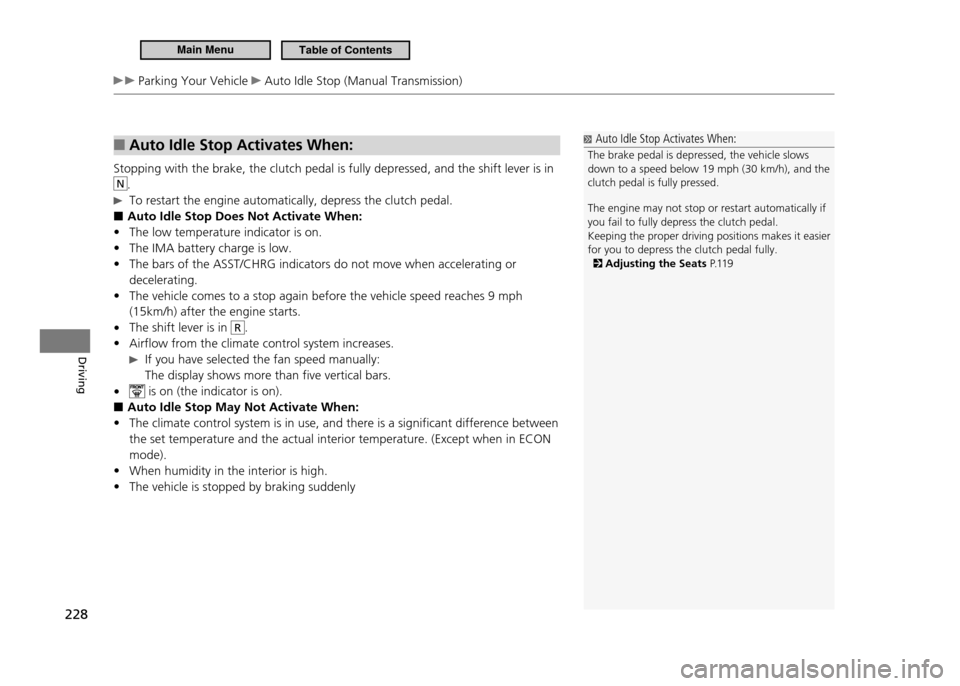
228
Driving
Parking Your Vehicle Auto Idle Stop (Manual Transmission)
Auto Idle Stop Activates When:
■
Stopping with the brake, the clutch pedal is fully depressed, and the shift lever is in
N.
To restart the engine automatically, depress the clutch pedal.
Auto Idle Stop Does Not Activate When:
■
The low temperature indicator is on.
•
The IMA battery charge is low.
•
The bars of the ASST/CHRG indicators do not move when accelerating or
•
decelerating. The vehicle comes to a stop again before the vehicle speed reaches 9 mph
•
(15km/h) after the engine starts.The shift lever is in
•
R.
Airflow from the climate control system increases.
•
If you have selected the fan speed manually:
The display shows more than five vertical bars.
• is on (the indicator is on).
Auto Idle Stop May Not Activate When:
■
The climate control system is in use, and there is a significant difference between
•
the set temperature and the actual interior temperature. (Except when in ECON mode).When humidity in the interior is high.
•
The vehicle is stopped by braking suddenly
•
Auto Idle Stop Activates When:
The brake pedal is depressed, the vehicle slows down to a speed below 19 mph (30 km/h), and the clutch pedal is fully pressed. The engine may not stop or restart automatically if you fail to fully depress the clutch pedal.
Keeping the proper driving positions makes it easie r
for you to depress the clutch pedal fully.
Adjusting the Seats P.11 9
Main MenuTable of Contents
Page 230 of 333
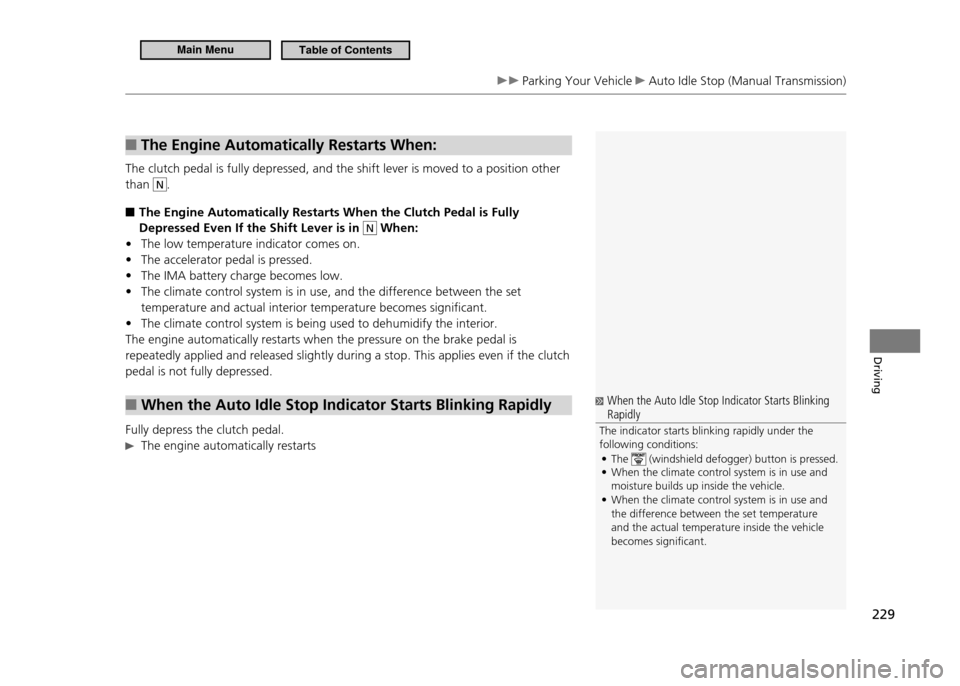
229
Driving
Parking Your Vehicle Auto Idle Stop (Manual Transmission)
The Engine Automatically Restarts When:
■
The clutch pedal is fully depressed, and the shift lever is moved to a position other than
N.
The Engine Automatically Restarts When the Clutch Pedal is Fully
■
Depressed Even If the Shift Lever is in
N When:
The low temperature indicator comes on.
•
The accelerator pedal is pressed.
•
The IMA battery charge becomes low.
•
The climate control system is in use, and the difference between the set
•
temperature and actual interior temperature becomes significant. The climate control system is being used to dehumidify the interior.
• The engine automatically restarts when the pressure on the brake pedal is repeatedly applied and released slightly during a stop. This applies even if the clutch pedal is not fully depressed.
When the Auto Idle Stop Indicator Starts Blinking Rapidly
■
Fully depress the clutch pedal.
The engine automatically restarts
When the Auto Idle Stop Indicator Starts Blinking
Rapidly
The indicator starts blinking rapidly under the following conditions: The
•
(windshield defogger) button is pressed.
When the climate control system is in use and
•
moisture builds up inside the vehicle. When the climate control system is in use and
•
the difference between the set temperature and the actual temperature inside the vehicle becomes signiicant.
Main MenuTable of Contents